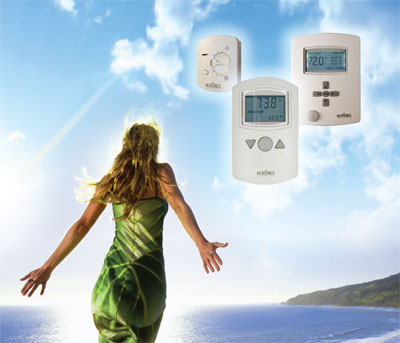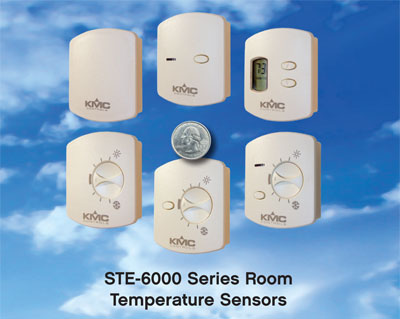KMC Sensors: Sensing Your Needs

Sensors and Their Relatives
In today’s buildings, sensors are essential devices in maintaining efficient operation and healthy, comfortable environments for occupants. “Sensors” are used in diverse HVAC and Building Automation System applications and are closely related to several other types of devices.
- Sensors measure a physical characteristic of an environment and provide a signal corresponding to those properties. Sensors may be stand-alone or integrated within a control device (e.g., a thermostat).
- Transmitters are also sensors, but take the relatively small (and passive) sensor signal (e.g., the resistance of a thermistor in response to a temperature) and convert it into an active voltage (e.g., 0–5 VDC) or active current (e.g., 4–20 mA). Boosting the signal allows greater distance between the sensor and the controller.
- Transducers convert one kind of energy into another. The physics may be different, but they can function as sensors. In building automation, transducers may convert pressure into voltage or current (or vice versa) or voltage signals into current signals (or vice versa).
- In building automation applications, many sensors, transmitters, and transducers perform essentially the same function, sensing a physical characteristic and providing a signal to an external control device. Thermostats, on the other hand, contain a sensor integrated with a control device. Thermostats may be as simple as a bimetallic switch or be sophisticated digital devices. FlexStats, for example integrate a native BACnet controller with a temperature sensor and optional humidity, motion, and/or CO2 sensors.
In building automation systems, sensors monitor air (temperature, humidity, CO2 levels, CO levels, smoke, flow rate or pressure), water (temperature or pressure), or even motion/occupancy of people.
Temperature and Humidity
 Temperature
sensors are the most familiar and most common types of sensors in building
automation. The compact
STE-6000 series room temperature sensors offer various setpoint, override,
and display options. The
STE-1400 series contains a variety of temperature sensors for a multitude
of applications, including the temperature of air inside rooms, inside ducts,
and outdoors, as well as the temperature of the heating/cooling water inside
pipes.
Temperature
sensors are the most familiar and most common types of sensors in building
automation. The compact
STE-6000 series room temperature sensors offer various setpoint, override,
and display options. The
STE-1400 series contains a variety of temperature sensors for a multitude
of applications, including the temperature of air inside rooms, inside ducts,
and outdoors, as well as the temperature of the heating/cooling water inside
pipes.
Depending on the climate, however, temperature alone
doesn’t tell the whole story about human comfort. A (dry bulb) sensor
temperature of 72° would feel very different to us at 10% relative humidity than
it would at 90% relative humidity. Too much or too little humidity can be
uncomfortable for people or even damaging to materials. KMC’s
THE-1xxx series humidity sensors can measure humidity in rooms or ducts.
KMD-1x8x NetSensors and
FlexStats
with the optional humidity sensor measure and display room temperature as well
as humidity.
Carbon Dioxide and Motion
How much
ventilation and conditioning of the air is needed for a space depends on how
many people are occupying that space...if any at all. For spaces with variable
occupancy (such as meeting rooms, classrooms, theaters, gyms, retail stores, and
hotels), considerable energy savings can be obtained by determining the actual,
real-time level of occupancy (compared to the “worst-case” design occupancy) and
reducing the ventilation and conditioning accordingly (to just the right amount
but no more).
Motion sensors can determine a simple yes-or-no occupancy state.
KMD-12x1 NetSensors and FlexStats with the optional
motion sensor (with an effective range of up to 33 feet) provide a convenient
means of concluding if anybody’s home inside a room.
Motion sensors can only determine whether or not
at least one person is in a particular
space, but the ventilation needs of a few people are very different from the
needs of a few dozen or a few hundred people. A complementary and more
sophisticated approach to occupancy determination senses the gas that people
breathe out. By measuring the levels of CO2,
Demand Control Ventilation (DCV)
estimates the amount of
occupancy and required (healthy) levels of ventilation and adjusts the
ventilation accordingly.
SAE-1011/1012/1062
CO2 detectors provide CO2 measurements in rooms or ducts
to external controllers.
FlexStats with the CO2 sensor option integrate demand
control ventilation with temperature and optional humidity control.
Carbon Monoxide and Smoke
Excessive levels of CO or combustion particulates mean not
just discomfort, but danger!
SAE-1100 series CO detectors watch for this deadly and invisible gas.
Also, where there’s smoke, there’s fire, and early detection is critically
important.
CAE-1003/1103
Flow and Pressure
Although behind the scenes, the amount of and pressure of
air and/or water flow are important factors in the efficiency of HVAC operation.
SSS-1000 series and
SSE-1000/2000 series flow sensors help determine how much air is flowing in the
system. The various
TPE-1xxx series pressure transducers provide pressure readings of air or
water.
Sensor Models
See this sensor model comparison chart to find the sensing
and mounting types you are looking for.
|
Sample Model Series
|
Sensing Types
|
Mounting Types
|
|
|
Temperature
|
Humidity
|
Motion
|
CO2
|
CO
|
Smoke
|
Flow and Pressure
|
Wall
|
Duct and Other
|
|
FlexStat
|
X
|
X
|
X
|
X
|
|
|
|
X
|
|
|
NetSensor
|
X
|
X
|
X
|
|
|
|
|
X
|
|
|
CAE-1003/1103
|
|
|
|
|
|
X
|
|
|
X
|
|
SAE-1000
|
|
|
|
X
|
|
|
|
X
|
X
|
|
SAE-1100
|
|
|
|
|
X
|
|
|
X
|
X
|
|
SSE-1000/2000
|
X
|
|
|
|
|
|
X
|
|
X
|
|
SSS-1000
|
|
|
|
|
|
|
X
|
|
X
|
|
STE-1400
|
X
|
|
|
|
|
|
|
X
|
X
|
|
STE-5200/5300
|
X
|
|
|
|
|
|
|
X
|
|
|
STE-6000
|
X
|
|
|
|
|
|
|
X
|
|
|
THE-1xxx
|
X
|
X
|
|
|
|
|
|
X
|
X
|
|
TPE-1xxx
|
|
|
|
|
|
|
X
|
X
|
X
|
|
For details on these and other sensors, see their data sheets as well as the KMC
product catalogs.
|
Additional Resources
KMC Sensors Brochure (SB-057)
Like a Breath of Fresh Air: Using CO2 Sensors with Demand Control Ventilation
Motion Sensors for More Efficient Control
Benefits of Controls in Green Buildings
Why Green Buildings Are Good
Thinking about Thermostats
Feedback